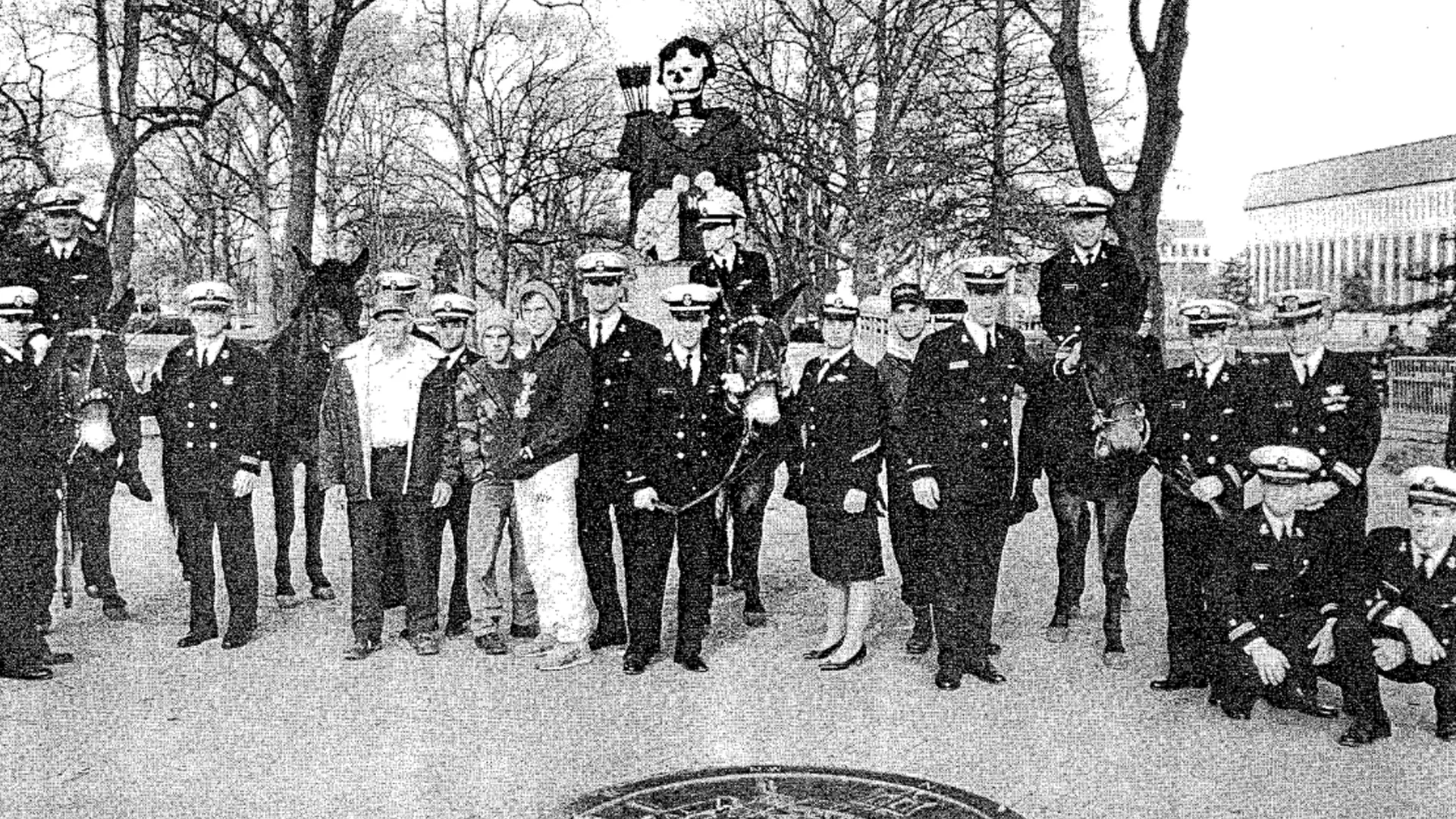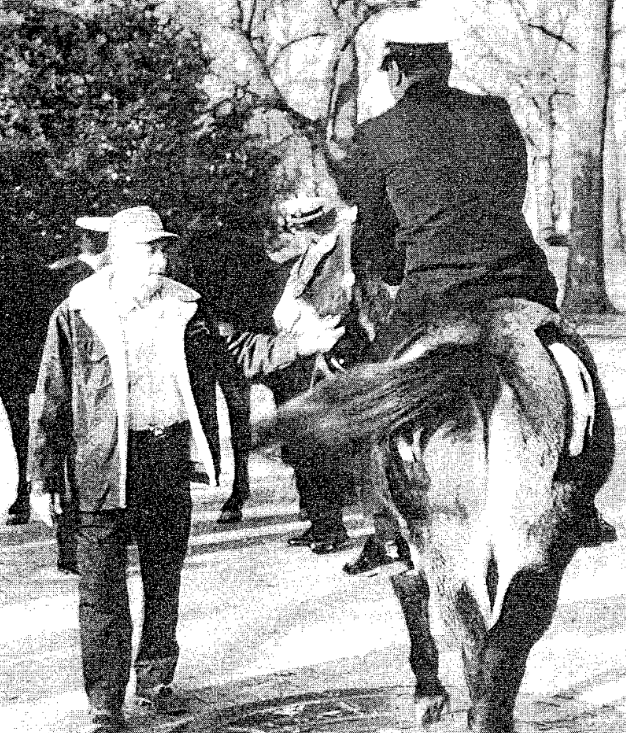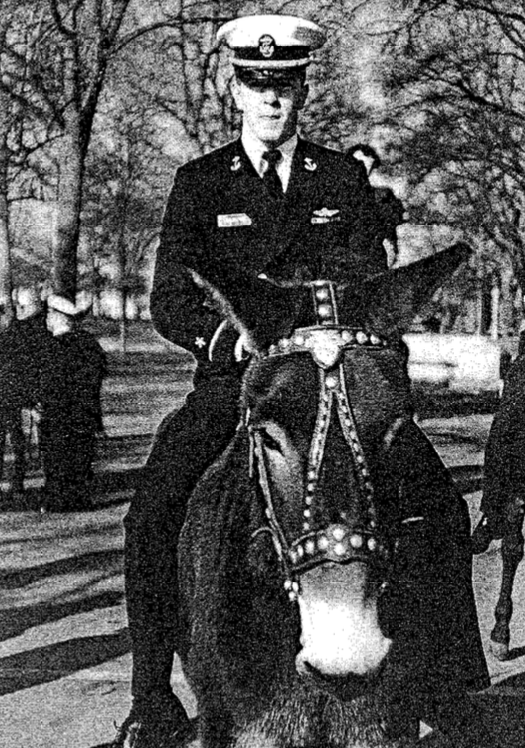

Revenge. Espionage. Disguises. A car chase. A helicopter search. This is not a Cold War spy thriller or a Las Vegas casino heist: instead, it’s a chronicle of an intercollegiate prank between two service academies, both alike in dignity, executed with the highest levels of military professionalism.
On December 5, 1991, 17 Naval Academy midshipmen, two advisors and a Maryland mule farmer snuck onto the campus of their eternal rival, the U.S. Military Academy at West Point, to kidnap West Point’s beloved mascots: four one-thousand-pound mules. What happened next was the culmination of nearly a year of meticulous planning that cemented those midshipmen in the annals of U.S. Naval Academy lore — and may have contributed to the Navy pummeling West Point in their annual Army-Navy football game the next day.
“Our jaws just hit the ground,” said Dan Goldenberg, a 1992 Naval Academy graduate who was at the pep rally when the raiding party made their triumphant return atop the captured mules.
‘Operation Missing Mascot,’ as the prank was called by midshipmen, had its roots in revenge. The previous year, West Point cadets stole the Naval Academy’s Bill the Goat XXVII. Though the goat was not the official Academy mascot at the time, he “was sick at the time and had to be put to sleep as a result of his captivity,” according to an article about the operation that appeared in the February 1992 edition of The LOG, a humorous magazine run by Naval Academy midshipmen (The article appeared to have been written by one of the pranksters, but no byline was listed).
The West Point cadets had cut several padlocks to kidnap Bill the Goat from the Naval Academy Dairy Farm, an actual farm the academy had started in 1911. The farm closed in the late 1990s because of high operating costs, but its location about 20 miles off campus made it an easy target for West Point cadets to sneak in and steal Bill away in a pickup truck.
The cadets had no way of knowing that they were to reap the whirlwind for what they had sown. In January 1991, the commander of the Brigade of Midshipmen and several classmates began planning their vengeance.

But stealing the West Point mules seemed to be a near-impossible feat.
“Stealing Bill the Goat is one thing. A small farm animal weighing 100 pounds is led out of a remote barn some 20 miles from USNA,” wrote The LOG chronicler. “An Army mule weighs over one thousand pounds and has to be specially transported … Of course, that is if one can even get on base and successfully infiltrate where the mules are kept.”
Unlike Bill the Goat, the four mules — Spartacus, Trooper, Ranger and Traveler — lived in a pen on a busy section of West Point’s campus.
“Thus, this was not going to be a little trip into the country, but an insertion deep into the heart of enemy territory,” the chronicler wrote. “After the initial intelligence was gathered, the feasibility of this mission was in serious question.”
Subscribe to Task & Purpose Today. Get the latest military news, entertainment, and gear in your inbox daily.
Then there was the matter of the mules themselves, which would need to be guided onto trailers and kept healthy across a long voyage. The midshipmen would need professional help, but luckily they found the perfect accomplice. Weir “Tennessee” Denton was a 67-year-old retired civilian mule farmer from Anne Arundel County, Maryland who had a personal grudge against West Point. Denton used to work at the Naval Academy Dairy Farm, and one night in the early 1940s while he was on watch, West Point cadets opened a gate to let the dairy cows roam the street. While Denton and a few Marines gathered the cows, the cadets kidnapped Bill the Goat.
“Tennessee never forgot that night and leapt at the opportunity to avenge Army,” the LOG chronicler wrote.

(Screenshot via The LOG Magazine/U.S. Navy)
Goldenberg, the 1992 graduate who was at the pep rally, remembered how important it was to the raiders that the mules were well-cared for so that they would not suffer the same fate as Bill the Goat the previous year.
“The guys were determined to do it right and take good care of the animals,” he said. “If you talk to any of the guys who did this, they’ll all talk about being trained how to properly handle the mules.”
The team of midshipmen and advisors gathered intelligence over the summer and fall. Over Labor Day weekend, one team conducted a scouting expedition where they entered West Point disguised as tourists and fed the mules sugar cubes while taking photos and noting nearby obstacles. The midshipmen held planning meetings “at night in deserted rooms, and in secure buildings” to prevent breaches in security, the chronicler noted. Goldenberg said he was completely unaware of the plot despite being friends with several of the participants.
“I had no idea,” he said. “They did such a good job with security, it was a total shock.”
Eventually, the team set a date to launch the mission: November 29, 1991.
The midshipmen dressed as tourists in civilian clothes and kitted themselves up with communications gear before “casually” assembling at a football field about 100 yards from the veterinary clinic where the mules were kept. The plan was to sneak into the clinic at the mules’ feeding time at 3:30 p.m. Time passed: the “tourists” played touch football while their advisor rode a bicycle around the area. The team was ready to go, with a mule trailer and transport ready to spring into action, but after three hours the midshipmen realized the feeding time must have gone early and the mission had to be abandoned.
“A very disappointed group reassembled … and transported to USNA,” the chronicler wrote. “The plan was right, but intelligence had been incomplete and we would try again next year.”

Turns out they did not have to wait so long. At a secret meeting on December 3, the senior advisor and two mission leaders decided to launch the mission that Thursday, December 5, though it would require a change of roster. Since it was a school day, only upperclassmen could go, and some of the original November 29 participants could not make the trip. The midshipmen improvised, and on December 4, the team mounted up for a trip to “a roach motel” five miles from West Point, with a brief stop at Denton’s farm to brush up on mule handling skills. They arrived at the motel at 5:30 that morning in cars disguised with West Point paraphernalia such as “I Love My Cadet” and “Go Army-Beat Navy” stickers.
“Adrenaline was beginning to run high as the team was less than three hours from H-hour,” the chronicler wrote.
At 7:00 a.m., the members of the two “assault teams,” Alpha and Bravo, dressed in utilities complete with Army enlisted insignia and military police gear that an advisor had bought from Fort Meade, Maryland earlier that year. The midshipmen checked their costumes for authenticity, loaded up with communications gear and cleared the motel rooms and parking lot to make sure no compromising evidence was left behind before the final briefing began at 7:30.
“Each person knew their part of this impossible dream,” the chronicler wrote. “Every team member had to perform in a professional manner they had never known before.”
‘Professional’ is an apt term: the team had multiple approach and escape routes memorized and a series of radio code names for each team and each of the five phases of the operation. This was no drunken college fraternity antic, it was a surgical operation burdened with the weight of institutional pride.
“There was no turning back and absolutely no failure,” the chronicler wrote. “The fate of history, the pride of USNA and its graduates, and very well the pride of the fleet was resting on this team’s shoulders. We would succeed.”

The team drove out for West Point at 9:00 a.m. It is difficult to guess what may have been going through each midshipman’s head on the drive to West Point, but the chronicler provided a meticulous list of the exact roles each student was expected to play in the upcoming heist.
Each assault team was led by an assault leader who, by hook or by crook, “could not fail to gain entrance to the compound,” the chronicler wrote. Behind the leaders were “methods of entry” specialists who carried bolt cutters and a maul to make that entrance a certainty. Behind the MOE specialist were the intelligence and electronics specialists, armed with electronics gear and cuffs, who would neutralize phones and alarms. Then there were the “man handlers,” who were armed with cuffs, gags and riggers tape and had been “specially picked for size and aggressive desire to place an enemy in submission.” Finally, there was “the door man,” the last one in who was responsible for keeping the curious away from the compound.
Accompanying the assault teams was the mule-handling team, a group of three men who had to leap the steel and concrete fence surrounding the pen.
“Their task: in less than three minutes they were to catch, put in a headlock and then bridle these animals,” the chronicler wrote. “And of course, all this was to be done in broad daylight – and in the words of the team leader, ‘Look natural and do not draw attention to yourself.’”

Easier said than done, especially for the transport team, who had to look natural while backing up a horse trailer and pickup truck to the compound. At 9:15 the convoy rolled onto campus through an unguarded back gate. They arrived at the veterinary clinic at 9:19, where the assault and mule teams exited the vehicles while trying to look like relaxed enlisted soldiers. Assault team Alpha headed for the clinic’s front door while Bravo went to the barn door and the mule team went for the mule pen at the back of the compound.
“No MPs in sight,” the chronicler recalled. “It was a quiet Thursday morning at the West Point Stables as the normal daily routine was about to be suddenly interrupted.”
An Army sergeant let the Alpha team leader in through the front door, where the leader became a “true hero” by convincing the sergeant that he was there with a few men to load mule feed for the Army game and that a second group would come in from the barn side. Bravo team arrived, but the presence of about 14 unscheduled visitors making small talk about feed delivery could not go unnoticed. A first sergeant realized what was happening and yelled “Call the MPs!” but it was already too late: the ‘man handlers’ restrained the prisoners while the electronics specialists disconnected phone lines and checked alarms; the MOE specialists cut locks and the door man slipped a “Sorry We’re Closed” sign over the door.
“Like clockwork, prisoners were interviewed for knowledge of alarms and MP patrols and, at the same time, the mules were being loaded into the barn from the outside pen,” the chronicler noted.

One kidnapper later looked back on the mission with disbelief.
“Looking back, we went so far overboard, tying guys up,” Bill Wiseman, a senior who later served with the Navy SEALs, told the New York Times in 2018. Wiseman said they zip-tied Army employees to chairs and used duct tape to silence a few of the more resistant ones.
“You would never get away with that today,” he said. “I’m frankly amazed we didn’t get in a lot of trouble.”
By 9:28, the building was secure and the mules were waiting at the front barn door, content with a supply of sweet, molasses-based feed. All looked calm and undisturbed from the outside and the prisoners were under control. The transport arrived at 9:30 and the four mules were loaded in under a minute while people at a financial center across the street smoked and watched. By 9:32, the trailer pulled away and went out the gate. Meanwhile the assault teams kept an eye on the prisoners: turns out there were two Army officers, two enlisted soldiers and two civilians working in the downstairs portion of the building the entire time. At one point a midshipman disguised as an Army MP told the office workers that “the men upstairs were MS and were doing a security check because ‘You know, Navy is gonna try to take the mules.’ To which a confident reply from the office was “They’ll never do it,’” the chronicler wrote.
At another point, two cadets asked a midshipman disguised as an MP at the front door where the mules were going, to which the midshipman replied “’A rabies virus vial has been broken. The mules are being evacuated,’” the chronicler wrote. “Once again, who would question an MP?”
By 9:40 the assault teams were beginning to leave the compound, but the prisoners were becoming more difficult to control. Only two midshipmen and an advisor were left when, at 9:48, one of the six downstairs office workers came upstairs, found the prisoners and realized what was going on. The three infiltrators sprinted out to the advisor’s car while the enlisted soldier went to his own car to try to stop them.
“The last Navy car backed out of the parking lot to find himself blocked by the soldier,” the chronicler wrote. “He threw the gear in reverse and sped up the hill to another exit. The soldier leaped in his car and then began a high-speed chase for the gate.”
The soldier took a different route to try to block the fleeing Navy vehicle, but the advisor floored the gas pedal, held down the horn and swerved around the soldier’s car while the soldier himself dove out of the Navy car’s path. It was 9:53 when the last intruders left the gate. Time on base was 33 minutes, and the mules had been captured, but the soldiers at the gate had recorded the last car’s license plate number and federal and state authorities had been notified. On top of that, three West Point Huey Cobra helicopters had also been scrambled to search for the intruders.
But the midshipmen were prepared: instead of driving immediately south onto roads manned with federal and state police who were on the lookout, the mule trailer drove north to Albany, then west and south to Scranton, Pennsylvania before finally arriving in Anne Arundel County. The plan was to get the mules to the Naval Academy campus in time for the pep rally at 7:30 p.m., but the convoy arrived at the Academy gate at 7:15 only to find federal authorities waiting for them.
“We were removed from our vehicles and spread-eagled on the baseball backstop,” the chronicler wrote. “It seems we were guilty of grand theft mule.”

Luckily, the academy’s command duty officer came to the rescue and convinced the authorities to take the midshipmen off the backstop and give them a police escort onto academy grounds, where they were greeted as heroes. Goldenberg recalled that the gate where the raiders arrived could easily be backed up with traffic, particularly when there was a horse trailer, a convoy and multiple federal vehicles blocking the way.
The duty officer told the federal authorities, “‘look, you guys are blocking traffic, let’s take this on to the academy grounds and we’ll figure it out there,'” the 1992 grad said. “So they did and as soon as they were on the academy grounds she said ‘get the hell out of here, you have no jurisdiction.’ And that’s how we kept the mules.”
The next day, the Naval Academy football team beat Army 24 to 3, which the Annapolis Capital Gazette said was Navy’s only win of the season. But that was not the end of the journey for the pranksters, who were in hot water for some time after the raid. Midshipman 1st Class Chris Middleton told the Capital Gazette that the mission was planned to not cause any lasting damage, and they paid back an Army sergeant who apparently jumped out a window at West Point to raise the alarm.
“We didn’t hurt anyone and we compensated for everything we did,” he said. “We took along new locks to replace what we cut and we paid that big sergeant for ripping his uniform.”
The Army never pressed charges, according to the Capital Gazette, and the commandant of midshipmen created a unique honor for the raiders: “The Order of the Mule,” which described the mission to be “in the highest traditions of the naval service.”
The mission continues to have ripple effects years after it took place. Goldenberg, who is now executive director of the Call of Duty Endowment, a nonprofit dedicated to helping veterans place high-quality jobs, said it was one of the inspirations for launching the Space Force’s trophy from last year’s military-wide Call of Duty tournament into space.
“The value of a big gesture for morale and fun … it was never lost on me,” he said. “There’s room for inter-service rivalry: it’s good for morale, competition and creativity. We’re extending that spirit to the video game generation.”
Some of the pranksters went on to lead distinguished Navy careers. Goldenberg’s friends on the assault teams included three Navy SEALs, a Marine and a fighter pilot. But no matter where they go, perhaps those former midshipmen think of Operation Missing Mascot as one of their greatest achievements.
“This account is sure to go down in history as one of the greatest adventures ever in the Army/Navy rivalry,” the chronicler wrote. “As intelligence and results are collected, this story is sure to grow, so watch for the book. BEAT ARMY AGAIN!!!”
The latest on Task & Purpose
- The king is dead: Why would America want to retire the F-22?
- We salute the Marine Corps vet who chugged a beer from her prosthetic leg at a Lakers game
- Combat medic ‘voluntold’ to attend Army Best Squad competition ends up dominating the range
- Air Force F-35 maintainer shares what it’s like keeping ‘a flying computer’ ready to fight
- Why modern technology hasn’t rendered trench warfare useless in Ukraine
Want to write for Task & Purpose? Click here.
